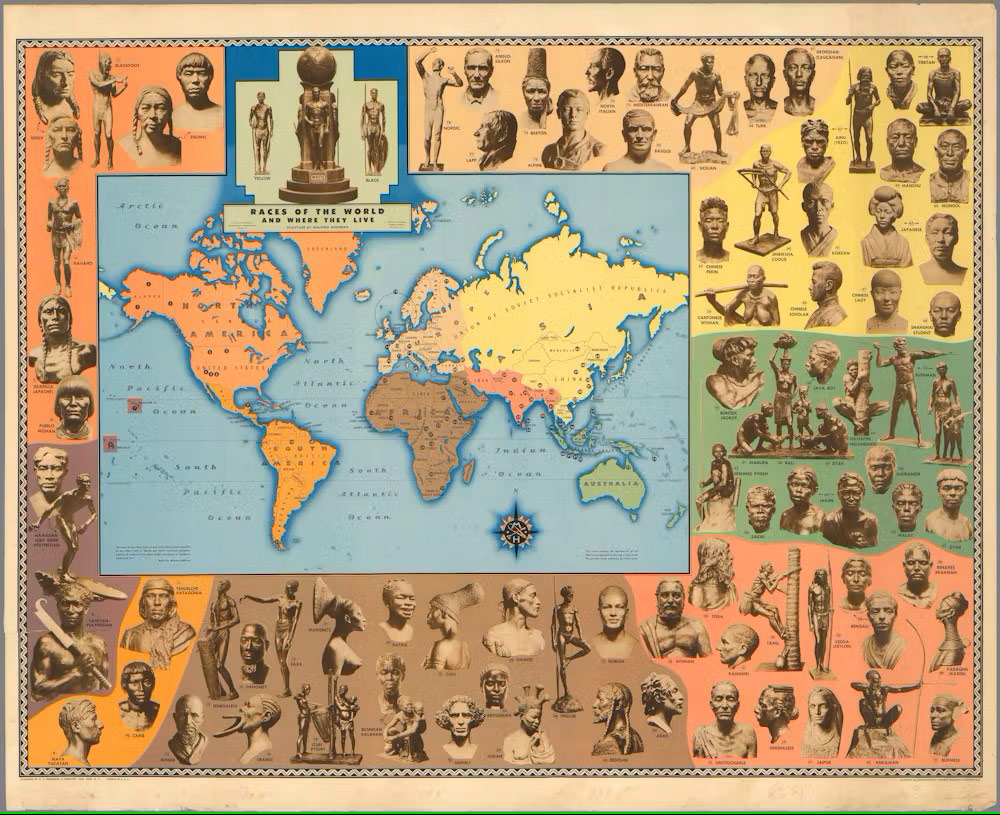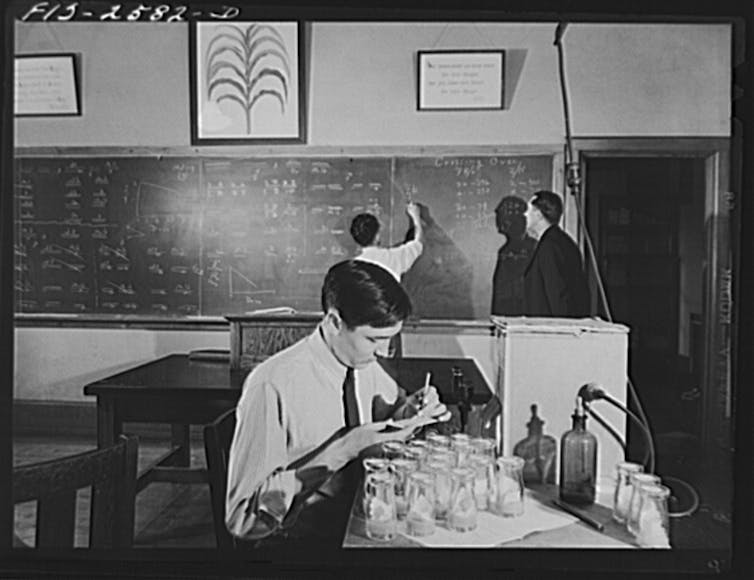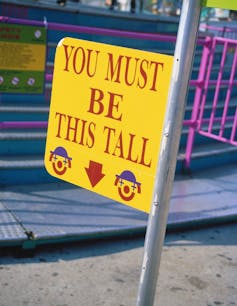
By John P. Jackson, Jr.
In the recent flurry of executive orders from President Donald Trump, one warned of “a distorted narrative” about race “driven by ideology rather than truth.” It singled out a current exhibition at the Smithsonian American Art Museum titled “The Shape of Power: Stories of Race and American Sculpture” as an example. The exhibit displays over two centuries of sculptures that show how art has produced and reproduced racial attitudes and ideologies.
The executive order condemns the exhibition because it “promotes the view that race is not a biological reality but a social construct, stating ‘Race is a human invention.’”
The executive order apparently objects to sentiments such as this: “Although a person’s genetics influences their phenotypic characteristics, and self-identified race might be influenced by physical appearance, race itself is a social construct.” But those words are not from the Smithsonian; they are from the American Society of Human Genetics.
Scientists reject the idea that race is biologically real. The claim that race is a “biological reality” cuts against modern scientific knowledge.
I’m a historian who specializes in the scientific study of race. The executive order places “social construct” in opposition to “biological reality.” The history of both concepts reveals how modern science landed at the idea that race was invented by people, not nature.
Race exists, but what is it?
At the turn of the 20th century, scientists believed humans could be divided into distinct races based on physical features. According to this idea, a scientist could identify physical differences in groups of people, and if those differences were passed on to succeeding generations, the scientist had correctly identified a racial “type.”
The results of this “typological” method were chaotic. A frustrated Charles Darwin in 1871 listed 13 scientists who identified anywhere between two and 63 races, a confusion that persisted for the next six decades. There were almost as many racial classifications as racial classifiers because no two scientists could seem to agree on what physical characteristics were best to measure, or how to measure them.
One intractable problem with racial classifications was that the differences in human physical traits were tiny, so scientists struggled to use them to differentiate between groups. The pioneering African American scholar W.E.B. Du Bois noted in 1906, “It is impossible to draw a color line between black and other races … in all physical characteristics the Negro race cannot be set off by itself.”
But scientists tried. In an 1899 anthropological study, William Ripley classified people using head shape, hair type, pigmentation and stature. In 1926, Harvard anthropologist Earnest Hooton, the leading racial typologist in the world, listed 24 anatomical traits, such as “the presence or absence of a postglenoid tubercle and a pharyngeal fossa or tubercle” and “the degree of bowing of the radius and ulna” while admitting “this list is not, of course, exhaustive.”
All this confusion was the opposite of how science should operate: As the tools improved and as measurements became more precise, the object of study − race − became more and more muddled.
When sculptor Malvina Hoffman’s “Races of Mankind” exhibit opened at Chicago’s Field Museum in 1933, it characterized race as a biological reality, despite its elusive definition. World-renowned anthropologist Sir Arthur Keith wrote the introduction to the exhibition’s catalog.
Keith dismissed science as the surest method to distinguish race; one knows a person’s race because “a single glance, picks out the racial features more certainly than could a band of trained anthropologists.” Keith’s view perfectly captured the view that race must be real, for he saw it all around him, even though science could never establish that reality.
In the scientific study of race, however, things were about to change.
Turning to culture to explain difference
By 1933, the rise of Nazism had added urgency to the scientific study of race. As anthropologist Sherwood Washburn wrote in 1944, “If we are to discuss racial matters with the Nazis, we had better be right.”
In the late 1930s and early 1940s, two new scientific ideas came to fruition. First, scientists began looking to culture rather than biology as the driver of differences among groups of people. Second, the rise of population genetics challenged the biological reality of race.
In 1943, anthropologists Ruth Benedict and Gene Weltfish wrote a short work also titled The Races of Mankind. Writing for a popular audience, they argued that people are far more alike than different, and our differences owe to culture and learning, not biology. An animated cartoon short later gave these ideas wider circulation.
Benedict and Weltfish argued that while people did, indeed, differ physically, those differences were meaningless in that all races could learn and all were capable. “Progress in civilization is not the monopoly of one race or subrace,” they wrote. “Negroes made iron tools and wove fine cloth for their clothing when fair-skinned Europeans wore skins and knew nothing of iron.” The cultural explanation for different human lifestyles was more robust than confused appeals to an elusive biological race.
The turn to culture was consistent with a deep change in biological knowledge.

Jack Delano, U.S. Farm Security Administration/Office of War Information, CC BY
A tool to understand evolution
Theodosius Dobzhansky was a preeminent biologist of the 20th century. He and other biologists were interested in evolutionary changes. Races, which supposedly didn’t change over time, were therefore useless for understanding how organisms evolved.
A new tool, what scientists called a “genetic population,” was much more valuable. The geneticist, Dobzhansky held, identified a population based on the genes it shared in order to study change in organisms. Over time natural selection would shape how the population evolved. But if that population didn’t shed light on natural selection, the geneticist must abandon it and work with a new population based on a different set of shared genes. The important point is that, whatever population the geneticist chose, it was changing over time. No population was a fixed and stable entity, as human races were supposed to be.
Sherwood Washburn, who happened to be Dobzhansky’s close friend, brought those ideas into anthropology. He recognized that the point of genetics was not classifying people into fixed groups. The point was to understand the process of human evolution. This change reversed everything taught by Hooton, his old teacher.
Writing in 1951, Washburn argued, “There is no way to justify the division of a … population into a series of racial types” because doing so would be pointless. Presuming any group to be unchanging stood in the way of understanding evolutionary changes. A genetic population was not “real”; it was an invention of the scientist using it as a lens to understand organic change.

Buena Vista Images/Stone via Getty Images
A good way to understand this profound difference relates to roller coasters.
Anyone who’s been to an amusement park has seen signs that precisely define who is tall enough to ride a given roller coaster. But no one would say they define a “real” category of “tall” or “short” people, as another roller coaster might have a different height requirement. The signs define who is tall enough only for riding this particular roller coaster, and that’s all. It’s a tool for keeping people safe, not a category defining who is “really” tall.
Similarly, geneticists use genetic populations as “an important tool for inferring the evolutionary history of modern humans” or because they have “fundamental implications for understanding the genetic basis of diseases.”
Anyone trying to pound a nail with a screwdriver soon realizes that tools are good for tasks they were designed for and useless for anything else. Genetic populations are tools for specific biological uses, not for classifying people into “real” groups by race.
Whoever wanted to classify people, Washburn argued, must give the “important reasons for subdividing our whole species.”
The Smithsonian’s exhibit shows how racialized sculpture was “both a tool of oppression and domination and one of liberation and empowerment.” Science agrees with its claim that race is a human invention and not a biological reality.
The Conversation U.S. receives funding from the Smithsonian Institution.
![]()
John P. Jackson, Jr. is Professor of History and Philosophy of Science at Michigan State University.




























Pogo says
@John P. Jackson, Jr.
Thanks professor, nice work; and nice work for those who can get it.
DaleL says
Even if the concept of race (ancestry) was in the past useful, it is much less so now. People are mixing and interbreeding to a degree that did not happen thousands of years ago. Racial terms come and go. I wonder when “Black” and “White” will fall out of favor as have the other skin color identifiers (red, yellow, brown).
Pogo says
@DaleL
Bulworth was right.
https://www.google.com/search?q=Bulworth
Now, as ever, the flea (eternal conveyor of plague) is wagging the dog; money never sleeps.
https://www.google.com/search?q=plague